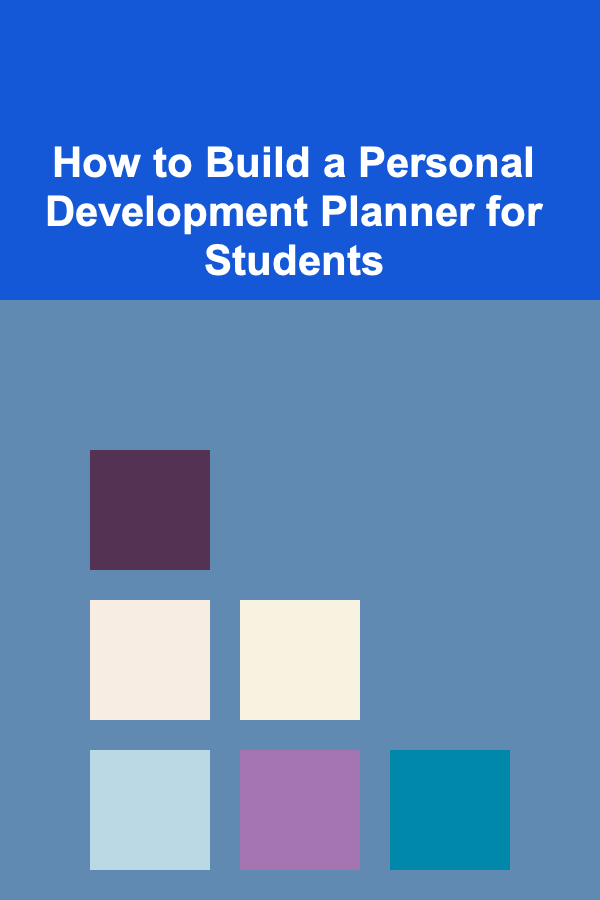
How to Build a Personal Development Planner for Students
ebook include PDF & Audio bundle (Micro Guide)
$12.99$11.99
Limited Time Offer! Order within the next:

Personal development is essential for students as it helps them grow not only academically but also emotionally, socially, and mentally. Building a personal development planner allows students to take charge of their growth, set clear goals, and track their progress in various areas of their lives. This comprehensive guide will walk you through the process of creating a personal development planner specifically designed for students.
Understanding Personal Development for Students
Personal development refers to activities that improve self-awareness, develop talents, enhance the quality of life, and contribute to the realization of dreams and aspirations. For students, this development can occur in various areas such as academics, career, health, social relationships, and emotional intelligence.
Personal development for students involves:
- Setting personal and academic goals.
- Managing time effectively.
- Building self-confidence and resilience.
- Developing interpersonal and leadership skills.
- Engaging in lifelong learning.
The goal of a personal development planner is to provide a structured framework for students to track and improve upon these various aspects of their life.
Why Every Student Needs a Personal Development Planner
A personal development planner offers several advantages for students, including:
- Clarity of Purpose: Students can set clear goals and break them down into actionable steps, helping them stay focused and organized.
- Increased Productivity: By scheduling tasks and tracking progress, students are less likely to procrastinate and more likely to meet deadlines.
- Self-Awareness and Reflection: A planner encourages regular reflection, helping students assess their strengths and weaknesses and adjust their strategies for improvement.
- Motivation: Seeing progress in personal and academic goals can increase motivation and inspire continued effort toward self-improvement.
- Balanced Life: A well-designed planner helps students balance their academic, social, and personal lives, reducing stress and promoting well-being.
Key Components of a Personal Development Planner for Students
To build an effective personal development planner, you should incorporate several key components that address various aspects of student life. These components include goal setting, time management, self-assessment, and reflection. Below are the essential elements of a comprehensive personal development planner for students.
3.1. Goal Setting Framework
Setting goals is a foundational element of personal development. A personal development planner should include a system for setting both long-term and short-term goals.
- Long-Term Goals: These goals focus on what students want to achieve over a period of months or years, such as graduating with honors, securing an internship, or mastering a new skill.
- Short-Term Goals: These are smaller, more immediate objectives that students can work toward on a weekly or monthly basis. They should be measurable and achievable, such as completing a specific assignment, improving study habits, or reading a book.
For effective goal setting, students should follow the SMART criteria:
- Specific: Clearly define what you want to achieve.
- Measurable: Identify how success will be measured.
- Achievable: Make sure the goal is realistic and attainable.
- Relevant: Ensure the goal aligns with personal values and priorities.
- Time-Bound: Set a deadline for achieving the goal.
3.2. Time Management Tools
A personal development planner for students should help them manage their time efficiently, ensuring that they can balance academic responsibilities with personal and social activities.
- Weekly and Monthly Schedules: Include a section for students to plan their week and month. This section should allow for flexibility while also allocating time for study sessions, assignments, and extracurricular activities.
- Task Lists: Encourage students to create task lists for each day or week, breaking larger goals into smaller, actionable tasks.
- Time-Blocking: Teach students to use time-blocking techniques to dedicate uninterrupted blocks of time to important tasks.
- Prioritization: Guide students to prioritize tasks based on urgency and importance, helping them focus on high-impact activities first.
3.3. Self-Assessment and Reflection
Regular self-assessment and reflection are crucial to personal growth. A personal development planner should include tools that help students assess their progress, identify strengths, and acknowledge areas for improvement.
- Daily or Weekly Reflection: Dedicate space for students to reflect on their achievements, challenges, and areas where they can improve. Reflection allows students to learn from their experiences and adjust their approach.
- Progress Tracker: Include a progress tracker for students to track their progress on specific goals. This could be in the form of checklists, charts, or visual representations that provide a clear picture of what has been accomplished.
- Strengths and Weaknesses: Help students identify their strengths and weaknesses through regular self-assessments. This self-awareness helps students make informed decisions about where to focus their efforts for improvement.
3.4. Motivation and Inspiration Section
Maintaining motivation throughout the school year can be challenging for many students. A personal development planner can include sections to help students stay inspired and motivated.
- Quotes and Affirmations: Include motivational quotes or affirmations that students can read daily to keep their spirits high.
- Vision Board: Encourage students to create a vision board or a collage of images, goals, and dreams that inspire them. This visual representation of their aspirations can act as a constant reminder of what they are working toward.
- Celebrating Achievements: Make room for students to celebrate their small wins along the way, which can serve as positive reinforcement to continue striving toward bigger goals.
3.5. Academic Development Tracker
Since academics are central to a student's life, a personal development planner should also focus on academic growth. This section can include:
- Study Plans: Guide students in creating structured study plans for exams, assignments, and projects. This will help them organize their studies and avoid last-minute cramming.
- Grades Tracker: Students can track their grades in each subject, setting improvement goals and identifying areas where they may need additional support.
- Skill Development: Encourage students to identify specific skills they want to develop, such as writing, research, or public speaking, and to work toward mastering them.
3.6. Personal Well-Being Section
A personal development planner should also promote mental, emotional, and physical well-being, as these areas significantly impact a student's ability to succeed academically.
- Health and Fitness Tracker: Include sections for students to log physical activities, track their exercise routines, and monitor their nutrition.
- Stress Management: Teach students to manage stress by incorporating relaxation techniques, such as deep breathing exercises or meditation, into their daily routines.
- Social and Emotional Health: Encourage students to prioritize self-care, social interactions, and emotional well-being through regular check-ins and social goals.
Building the Planner: Step-by-Step Process
Now that we understand the essential components, let's break down the process of building the personal development planner step by step.
Step 1: Define the Purpose and Focus Areas
Decide what the primary focus of the planner will be. Will it emphasize academics, personal growth, or overall well-being? Consider the needs and goals of the students you are designing the planner for.
Step 2: Create Goal-Setting Frameworks
Design a system where students can clearly set both short-term and long-term goals. Include sections for goal description, SMART criteria, and timelines.
Step 3: Incorporate Time Management Tools
Include daily, weekly, and monthly calendars where students can plan their activities. Provide space for time-blocking, task prioritization, and deadline management.
Step 4: Add Self-Reflection Sections
Leave ample space for students to reflect on their growth. Include prompts such as "What went well this week?" or "What challenges did I face, and how did I overcome them?"
Step 5: Integrate Motivation and Inspiration
Use motivational quotes, success stories, and vision boards to keep students inspired and focused on their goals.
Step 6: Ensure Academic Tracking
Include sections for study schedules, grades, skill development, and academic goals to help students stay on top of their learning.
Step 7: Incorporate Well-Being Tools
Add health trackers, stress management activities, and prompts for social engagement to ensure that students are maintaining a balanced lifestyle.
Conclusion
A personal development planner is a powerful tool that can help students take control of their academic and personal growth. By incorporating goal-setting frameworks, time management strategies, reflection tools, and self-care practices, students can enhance their productivity, well-being, and overall success. Building a personalized planner empowers students to chart their own path toward continuous improvement, ultimately setting them up for a fulfilling and successful future.
Reading More From Our Other Websites
- [Home Maintenance 101] How to Master the Art of a Thorough Seasonal Home Maintenance Guide for Spring Cleanup and Summer Prep
- [Personal Investment 101] How to Build a Passive Income Stream with Rental Properties
- [Home Cleaning 101] Best Time‑Saving Home Cleaning Hacks for Busy Professionals
- [Home Family Activity 101] How to Have a Family Storytelling Night at Home
- [Organization Tip 101] How to Create a Study Space That Reflects Your Personality
- [Home Pet Care 101] How to Create a Pet Care Calendar for Your Family
- [Gardening 101] How to Create a Beautiful and Productive Backyard Garden
- [Organization Tip 101] How to Design a Herb Spiral for Efficient Use of Space
- [Survival Kit 101] The Importance of Water Purification Tablets in Your Emergency Preparedness Plan
- [Personal Financial Planning 101] How to Plan for College Expenses with a 529 Plan

How to Keep Your Home Organized with Storage Solutions
Read More
How to Plan a Balanced Diet for Weight Loss
Read More
How To Master Hair Curling with Different Tools
Read More
Debunking Chemtrail Theories: Science vs. Speculation
Read More
How to Plan a Bible Study for Beginners
Read More
10 Tips for Planning Your Academic Career
Read MoreOther Products

How to Keep Your Home Organized with Storage Solutions
Read More
How to Plan a Balanced Diet for Weight Loss
Read More
How To Master Hair Curling with Different Tools
Read More
Debunking Chemtrail Theories: Science vs. Speculation
Read More
How to Plan a Bible Study for Beginners
Read More